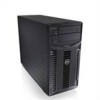Dell PowerEdge T410 Deploying UEFI-Aware Operating Systems on Dell PowerEdg - Page 5
What UEFI has to Offer, How is Dell's UEFI implemented? - usb
 |
View all Dell PowerEdge T410 manuals
Add to My Manuals
Save this manual to your list of manuals |
Page 5 highlights
What UEFI has to Offer The primary goal of UEFI is to define an architecture that can scale with time and to offer structured coding environment allowing easy enablement of new technology. The main characteristics of UEFI are: Abstraction for the Operation System. The UEFI specification provides an interface between the platform firmware and the operating system. The interfaces/API/protocols mark a clear boundary between the firmware and the operating system and the operating system loader. Abstraction for devices and related code. UEFI abstracts interfaces that make it possible to build code which works on a range of underlying hardware devices without having explicit knowledge of the specifics for each device. The specification defines interfaces to platform capabilities such as standard bus types (PCI, USB, and SCSI). The list of supported bus types may grow over time. These defined interfaces and the ability to extend to future bus types are components of the UEFI Driver Model. Scalable platform environment. The specification defines a complete solution for the firmware to describe all platform features and capabilities to the operating system during the boot process. These definitions cover a range of the contemporary platform designs but are simple enough to be able to extend in the future. Operating System Agnostic Rich Pre‐Boot environment. The UEFI specification defines extensible interfaces that enable creation of platform drivers. The drivers, analogous to operating system drivers, provide support for new devices and may provide enhanced platform capabilities, such as firmware update, platform configuration, diagnostics and deployment services. The existence of networking, USB, and file system capabilities adds to the richness of the pre‐boot environment. GUID Partition Table. The UEFI defines a new standard layout for the partition table, known as GUID Partition Table (GPT). GPT provides a more flexible mechanism for partitioning disks than the Master Boot Record (MBR) partitioning scheme that has been common to computers. MBR disks support only four partition table entries and the partition size is limited to 2TB. GPT scheme allows up to 128 primary partitions and can support larger than 2‐terabyte partitions. Some near‐term limitations to 2 terabyte support exist due to device support, but once devices fully support GPT/UEFI, this will no longer be an issue. See the "Limitations" section. How is Dell's UEFI implemented? To support booting to both UEFI and non‐UEFI aware operating systems, the Dell BIOS supports a Boot Mode option in the BIOS Setup Utility. The Boot Mode can be set to BIOS or UEFI. Setting the Boot Mode to UEFI allows booting to a UEFI‐aware operating system and provides the UEFI Boot Manager. This is the only change required to enable UEFI on the system. Setting the Boot Mode to BIOS provides support for all current and legacy operation systems. Page 3













